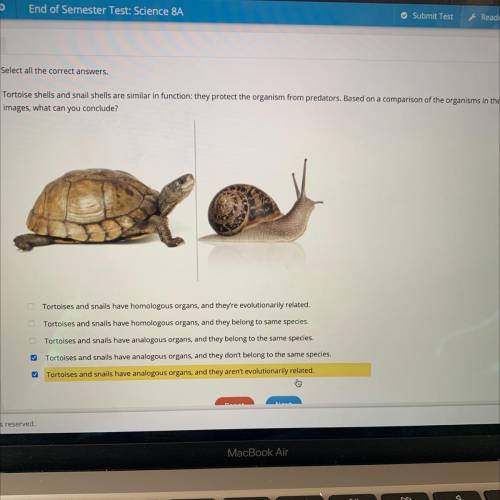
Biology, 18.12.2020 18:10 Perdikaris
Tortoise shells and snail shells are similar in function: they protect the organism from predators. Based on a comparison of the organisms in the
images, what can you conclude?
Tortoises and snails have homologous organs, and they're evolutionarily related.
Tortoises and snails have homologous organs, and they belong to same species.
Tortoises and snails have analogous organs, and they belong to the same species
Tortoises and snails have analogous organs, and they dont belong to the same species.
Tortoises and snails have analogous organs, and they aren't evolutionarily related.


Answers: 2


Another question on Biology

Biology, 21.06.2019 18:00
How is the motion of the particles of water at 80 ⁰c different from the motion of the particles of water when it is 30 ⁰c?
Answers: 1

Biology, 22.06.2019 03:30
Rease is an enzyme used by plants to break down urea (a nitrogen-containing compound) into carbon dioxide and ammonia. urease urea > > > carbon dioxide and ammonia ammonia is broken down by plants into a nitrogen source plants need to grow. thus, plants could not use urea as a nitrogen source unless it was first converted to ammonia. in soybean plants there are two different kinds of urease, one produced in the seeds and the other produced in the leaves of the plant. three types of soybean plants were used in a set of experiments: normal soybeans and two mutant strains, one lacking the urease in the seeds only (strain 1) and one lacking urease in the leaves only (strain 2). experiment 1 separate areas in a field were planted with normal, strain 1, and strain 2 soybeans. all types of soybeans appeared to grow, flower, and produce seeds equally well. there were no externally detectable differences among the strains. experiment 2 small pieces of plant leaves of equal weight were obtained from each type of soybean plant and separately placed on media in culture dishes. tissue growing in this way will become an unorganized clump of cells referred to as callus. to provide a controlled nitrogen source, half the tissue samples of each type were placed on media containing urea, and the other half of the samples were placed on media containing ammonia. after 30 days, the weight gain for each of the callus samples was determined. results are shown in the table below.
Answers: 2

Biology, 22.06.2019 04:10
Select the correct answer. tay-sachs disease is caused by a mutation in the hexa gene located on chromosome 15. tay-sachs follows an autosomal recessive pattern of inheritance. with the of the diagram, identify which of the offspring will be an unaffected carrier. a diagram showing the genes of parents who are carriers of tay-sachs disease a. a, b, and c b. b and c c. a and d d. a e. d
Answers: 3

You know the right answer?
Tortoise shells and snail shells are similar in function: they protect the organism from predators....
Questions

Mathematics, 15.10.2019 19:30

Health, 15.10.2019 19:30


History, 15.10.2019 19:30


History, 15.10.2019 19:30

Mathematics, 15.10.2019 19:30

Business, 15.10.2019 19:30






Biology, 15.10.2019 19:30

Mathematics, 15.10.2019 19:30


Mathematics, 15.10.2019 19:30



Mathematics, 15.10.2019 19:30




